Monaco
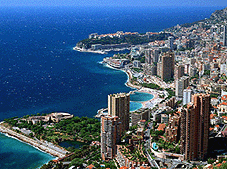 The most eastern part of the Côte d'Azur, not far from the Italian border, is better known as the Principality of Monaco. This little country was fouded in the 13th century by the Genuese Grimaldi family. Until 1860, also Menton and Roquebrune belonged to the Principality.
The most eastern part of the Côte d'Azur, not far from the Italian border, is better known as the Principality of Monaco. This little country was fouded in the 13th century by the Genuese Grimaldi family. Until 1860, also Menton and Roquebrune belonged to the Principality.Today, Monaco is still ruled by the Grimaldi family. With its 2 square kilometers it is almost the smallest country in Europe. Vatican City is only just a little bit smaller.
The inhabitants of Monaco are called Monegasks. The real Monegasks form the smallest community within the dwarph state, the larger part exists of French, Italians and rich foreigners from all over the world. Monaco has its own language called Monegasco, a mix between the Provençal language and a Ligurian dialect. The generally spoken language, however, is French.
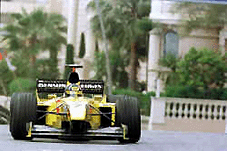 Apart from the fact that the principality is well known for being a tax paradise, it is also world famous for its Grand Prix through the streets of Monte Carlo, its capital.
Apart from the fact that the principality is well known for being a tax paradise, it is also world famous for its Grand Prix through the streets of Monte Carlo, its capital.
History
In prehistoric times, before the Stone Age, the area on which Monaco was founded was already inhabited. Around 900 B.C., when the Phoenicians lived here, a rock was dedicated to the God Baäl. After the Phoenicians, the Greeks arrived, who founded a trading post. In their footsteps the Romans arrived, who founded the harbour "Herculis Monoeci Portus". Just like France, Monaco saw people come and go, including the Saracens, whose rule only lasted for a short time.
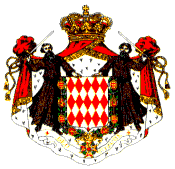 In the 13th century, Monaco fell into the hands of the Genuese. In 1215 a fortress was built, of which the remains can still be seen today. From 1297 Monaco was ruled by the Grimaldi family. In 1612 the rulers took the title of Prince of Monaco.
In the 13th century, Monaco fell into the hands of the Genuese. In 1215 a fortress was built, of which the remains can still be seen today. From 1297 Monaco was ruled by the Grimaldi family. In 1612 the rulers took the title of Prince of Monaco.In 1793 Monaco temporarily came under French rule, until 1814, when Monaco was given back to Prince Honoré IV. In 1860 Monaco became a French protectorate, and they had to give Menton and Roquebrun back to France. In 1866, Monte Carlo was founded, with a casino, an opera and a luxury hotel. In 1911 Prince Albert I gave the small state a constitution. In 1922, Louis II came into power, followed by Prince Rainier III. In 1956 Prince Rainier married the American actress Grace Kelly, who died in a horrible car crash in 1982, which shocked the world.
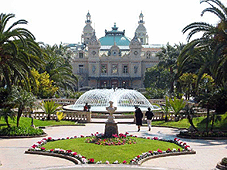 Sites
SitesThe original idea behind the Casino of Monte Carlo was to save Monaco from a treatening bankrupcy. The Casino was built in 1878 by architect Charles Garnier, the architect of the Opera in Paris.
In Monaco-Ville, the old town, we find the 13th century Palace. This palace is only opened for the public when the Prince is abscent. At 11.55 hours the changing of the guard takes place, an impressive sight!
In the Museum "des Souvenirs Napoléoniens" we find several artifacts and information connected with Napoleon Bonaparte, among which several personal objects and paintings of Napoleon and Josephine.
The Cathedral was built between 1884 and 1897 in Roman-Byzantine style. The altar piece is from the 15th century. Here you also find the tombs of the Princes of Monaco, several bisshops and the tomb of Princess Gracia (Gratia Patricia Principis Rainerii III).
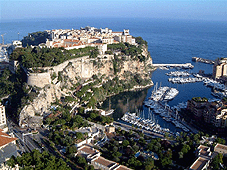 Close to the Cathedral we find the Palace of Justice, the Historical Museum (Historial des Princes) and the Chapelle de la Miséricorde from 1639.
Close to the Cathedral we find the Palace of Justice, the Historical Museum (Historial des Princes) and the Chapelle de la Miséricorde from 1639.
It is well worth to visit the Musée Océanographique. It was founded in 1910 by Prince Albert I. In the Sea Aquarium you can admire beautiful fish and plants. The world famous Jacques Cousteau had his research centre here. The museum has quite an impressive collection of diving gear and small models of ships.
The Jardin Exotique is a beautiful garden with a great variety of subtropical plants. In the park you also find the interesting Antropological Museum.
In the Musée des Automates et Poupées d'Autrefois you go back in time. Here you can admire a beautiful collection of dolls from the 18th century to the present.
The harbour of Monaco was built in the early 20th century. Here you can see all different sizes of everything that floats and a visit will certainly make an impression on you!